So you’d like to know how to get rid of moles in your yard or garden. Well, you’re in luck, we have a ton of experience with moles and by the end of this guide you will know exactly how to solve your mole problem. Everyone knows about bug sprays and mouse traps, but if you start talking to your friends or family about moles, you can expect some confused looks.

Moles are not widely renowned as pests, and very few people even know what they look like. Depending on who you ask, moles are either the cutest or the weirdest-looking pests around.
However you feel about their looks, there is no question that these little fellas are definitely pests! Part of what makes pests so troublesome is the challenge of finding them. Most pests don’t parade their way through your home. Instead, they love to hide and sneak, showing up at night or in the dark when no one is around.
Before you see a mole, you’ll see the evidence they leave behind. This usually takes the form of a “mole mound,” the upper trail of disturbance in the earth caused by mole tunneling.
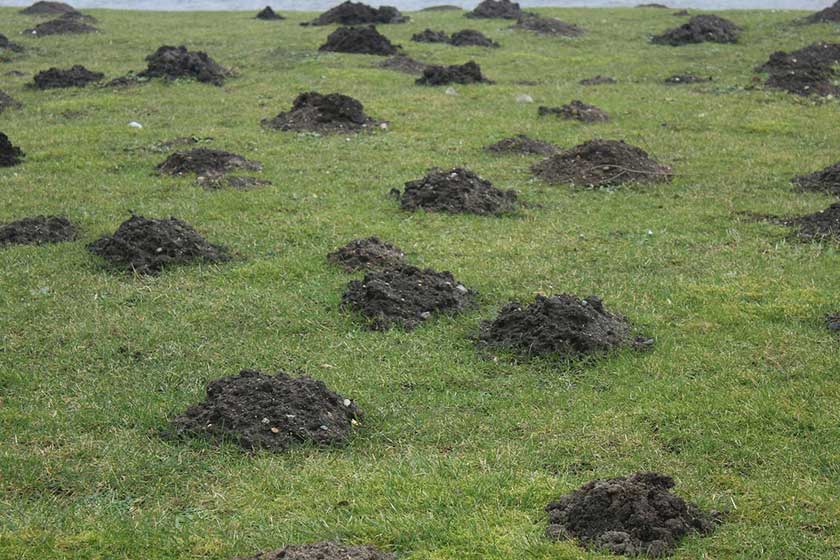
Moles in the Garden
For enthusiastic gardeners or other folks who work hard to maintain their backyard areas, moles are a HUGE problem. If those pesky garden dwellers do manage to make it into your outdoor living space, we’re here for you.
This is our overview of mole management, in which we will cover the nature of the mole, how to recognize them, and most importantly, how to get rid of them. Let’s start with some facts about moles to get a little foundation under us, and then we’ll talk solutions. Get ready to say goodbye to your moles! We also just wrote a page on our favorite mole traps here if you’re interested.
Tunnel Vision: Tracking and Identifying Moles

You will probably never see a mole just hanging out above ground, so in order to locate and get rid of them, you’ll want to carefully examine their tunnels. Mole tunnels are pretty complex systems, underground networks of intersecting pathways not totally unlike city subway systems. The tunnels that approach the surface are what you’ll be looking for during your mole hunt. The mole mounds left by tunnels are rounded dirt compositions three-to-five inches wide.
These mounds will noticeably break the surface of your yard or garden, and they are often seen alongside little mountains of dirt. Those mini-mountains represent a surfacing where the mole popped above ground level briefly. Together, the mounds/tunnels and tiny dirt mountains strongly suggest a mole presence in the area. Some of their tunnels fall into disuse over time, so be sure not to rely too much on older tunnels and openings. It won’t do you much good to try capturing a mole where it never visits anymore.
Some tunnels are just secondary pathways that connect to the main mole runway. Your main mole runways are often the straight-looking tunnel mounds through the yard, or those that follow your yard’s general perimeter. You can investigate a tunnel by using your finger or a small probe device to poke a nice little hole in the tunnel ceiling. Carefully watch that tunnel over the coming few days. If your damage is repaired quickly, as in one or two days later, it means you have located a mole’s main runway. Or at least an active tunnel. So long as it’s a commonly used path, you’re in good shape.
Active Mole Tunnels
It may take some time to locate an active tunnel, but the good news is that moles are not particularly communal pests. So if there are tunnels and mounds in your yard or garden, it’s likely that you won’t have to remove a whole crew of little diggers. In most cases, you can safely assume that only one or two moles have decided to chill beneath your yard.
Unlike with bugs and certain other pests, you can effectively control a mole infestation with just one or two instances of successful removal. So unless your mole is just superhumanly clever, take heart! Of course, repairing mole damage may take a little longer. But we’ll get to that — for now, let’s go over the available options for mole removal. After all, step one is to get those little guys out of your hair before they can cause any more damage.
Here are the Best Ways to Get Rid of Moles in Your Yard
As with most pests, moles can be managed using a few different options, depending on what’s comfortable or convenient for you. Your infestation, your yard, your rules. Some do-it-yourself- exterminators prefer to avoid lethal options, which is perfectly fine. Others don’t mind lethality, or at least prioritize the stability of their gardens, which is understandable too.
But before we dig into gadgets and tactics, one idea that floats around the world of mole management is insecticides. This is a controversial option in mole control due to the collateral damage it can cause. The idea is that you eliminate the mole’s food source, starving him or driving him elsewhere. But by using insecticides, you are also potentially killing off important insects that help your yard and garden to really thrive. There’s an ecosystem here, folks.
Insecticides are usually not very effective anyhow since they often fail to eliminate grubs and worms, two of the mole’s favorite treats. So not only are you hurting your yard, you’re not even taking care of the issue. Use insecticides at your own risk.
With that out of the way, browse our list of mole removal options and decide what works best for you. We’ll be looking at mole traps, mole bait, mole fumigators, and mole repellent.
Mole Traps (See Recommend Traps)
This is one of your most straightforward option to get rid of moles. Traps certainly get the job done, and in the vast majority of mole infestations, traps only have to catch one or two moles. Boom. Mole problem solved. Not all mole traps are lethal, and the ones that don’t kill a mole are often referred to as “humane” traps. We’ll stick with “non-lethal” for our purposes here.
Lethal mole traps rely on sharp spikes or blades to take care of the issue. A trap is inserted atop or within a tunnel. There is usually some kind of sensitive pressure mechanism holding the sharp parts at bay. A traveling mole will inevitably press upward toward one of these traps, and when it does, it’s game over. The trap will trigger and rapidly jut sharp spikes through the mole’s body or close on it with razor edges.
Multiple spikes through the body is not really a survivable condition. Another option is a metal spring trap that sweeps powerfully into the mole’s abdomen, crushing it and fixing the problem right quick. This model requires you to dig into the tunnel, so get ready to sift some soil.
Non-Leatal Mole Traps
Alternatively, non-lethal mole traps usually take the form of a small tube insert. Dig up a mole tunnel, insert the tube, cover the tunnel, and wait. Moles crawl in the tube and there they will stay until you retrieve your trap. This will technically become a lethal trap if you leave it in the tunnel and forget about it. Better to get the old spike for a quick ending than to be starved in a tunnel trap. Probably. We’ve never been caught in a mole trap, so what do we know?
But we have caught moles using traps, and we can say that the easier option is typically a trap that is placed above the ground. Digging can be something of a hassle, so if you prefer not to take the time for that, a lethal mole trap may be your best bet. You’ll want to be sure you’re targeting a main mole runway in any case. A trap set on or in an abandoned mole tunnel will probably catch a whole lot of nothing.
1. Wire Tek EasySet Mole Eliminator Trap
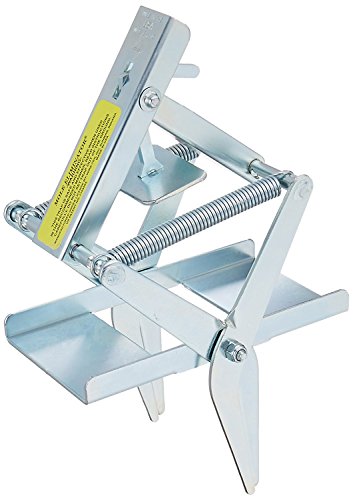
Does the Wire Tek Easy Set Mole Trap actually work? With an overwhelming amount of positive reviews, you don’t have to take our word for it.
You get what you pay for with this trap. One of the questions people always ask about this trap is “What is an easy way to release it to dump all the bodies.” That is a good sign…
For the price, this trap had better work! Otherwise, you just purchased an expensive and slightly dangerous paperweight.
Of all the traps out there, we find this trap to be the most effective. This trap is available in a two-pack, so make that a pair. More traps mean increased probability of catching moles.
Set one of these things above the main mole runway and prepare to feel accomplished. To be honest, virtually all lethal mole traps are on the expensive side. This one is not the worst-priced option either.
Wire Tek traps will work against any mole of any species, and there is no digging involved if you’re using the trap alone. You can step on the trap after planting it in order to really get it nice and stuck in. Incidentally, this is also how you set it. This feature may be more important than you think since setting it with your hands can end tragically if you’re not careful. But simply stepping on it after planting, and while wearing a shoe? Perfect!
You do have to be cool with mole killing though. If that’s not your scene, there are plenty of non-lethal options.
2. Aspectek Humane Tunnel Mole Trap (Not as Effective as Lethal Traps)
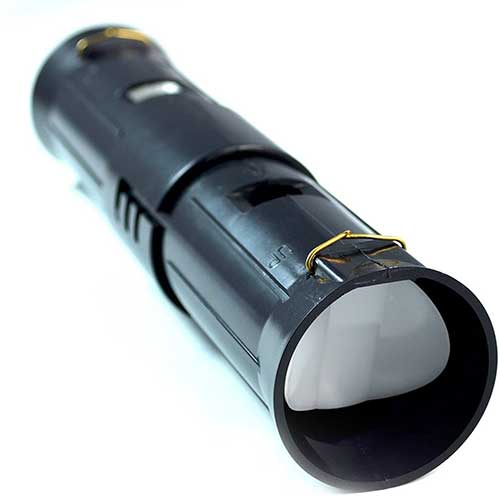
Aspectek Human Mole Trap is a non-lethal option to catch moles. Here we have the old catch-and-release method for folks who want to avoid the blood. Or folks who would like a new pet mole, which we do not recommend. Either way, this trap is basically a one-way-door trick piece. Moles crawl in, moles stay a while. Specifically, they stay until you let them out. Hey, we can’t complain about a solution that doesn’t involve a dead mole stuck on the end of some weird knives.
The moles will undoubtedly be just utterly terrified inside their temporary capsule, especially once you pick it up and haul it off to your unloading site. Consider this revenge for messing up your lawn area. Unlike the WireTek mentioned above, this trap will require you to dig into an actual mole tunnel. If you don’t mind getting your hands dirty, this is a solid option.
Some users complain that their soil is too sandy for the trap to work, or that its little doors don’t properly close if the trap isn’t placed level. As with all traps, this is best paired with bait, and if it doesn’t catch any moles the first day, relocate and try again. One last bonus, though, is that this trap runs for a significantly lower price than lethal devices.
Related Article: 9 Best Mole Traps
Mole Baits (See Recommended Baits)
What’s a trap without bait? This is always the slightly sneakier component of the bait/trap duo. It looks good, it smells good, and it is deliberately enticing a critter in order to capture or kill it. Most mole bait is not inherently benign either. The bait is commonly marketed in poisonous form, meaning that you’ll be planning that mole’s final meal. Of course, this means you won’t know exactly where he has dropped dead, so as you repair the damage to your yard, be ready to uncover a dead mole or two if you used poison bait to take care of business.
Mole bait comes in a couple of different packages. There is pellet bait, which, well, comes in pellets. The pellets are poisonous, the moles eat the pellets. Pretty straightforward. Another option is imitation grub: Synthetic, poisonous worm things designed to seem oh-so-juicy to a hungry mole as it tunnels below your property. This is why you don’t eat random grubs you find lying around, readers.
3. Tomcat Mole Killer Bait (Grubs and Worms)
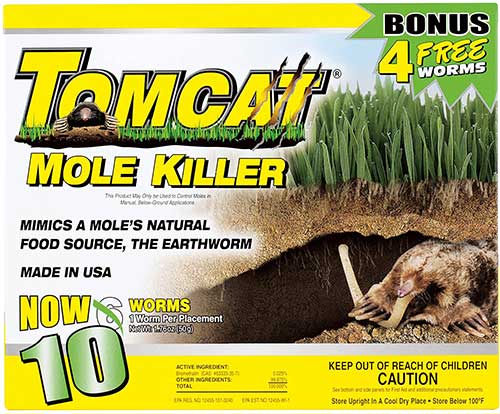
Tomcat mole Killer is another type of Poison! This is one of the higher-rated imitative baits on the market right now. Tomcat’s mole killer comes in either worm or grub form, meaning that it eliminates moles by imitating something they would actually eat in the wild. Synthetic worms and grubs can be placed in mole tunnels just like any other poison bait. If you can manage to fix some of these to the business end of a mole trap, that will be just the ticket.
The box indicates that this product now comes with 10 worms to dwarf its previous meager allotment of six. That’s four free bonus worms, people. Synthetic worm-shaped mole poison doesn’t grow on trees, you know.
One worm per tunnel placement is sufficient for a mole infestation, so don’t feel like you need to litter your backyard. This is effective against the most common species of mole, and the reviews support that. For moles who dodge traps and reject pellets, some lethal trickery like this might do the trick.
4. Tomcat Mole and Gopher Bait
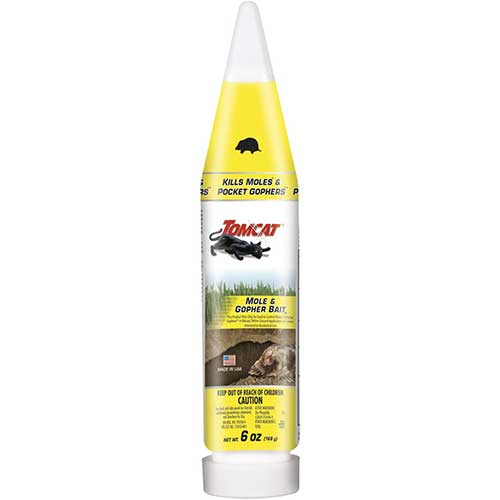
The Tomcat mole and gopher bait is a poison to kill the moles. This time, we’re looking at one of their takes on bait, which comes in pellet form. It’s sold in a six-ounce bottle, so there isn’t a ton of it. Tomcat must be very confident in the quality of their product. This stuff apparently also works if you have a gopher or mole problem and it is sealed in a resistant bottle for easy and safe use.
These pellets are poisonous, and the container should be kept well away from kids or pets that might want to get into it. The pellets are to be dropped into the mole tunnels, where their enticing odor will draw moles to their deaths. This is another Tomcat product with 50/50 reviews. Some customers use the pellets to great effect, and others are flatly dissatisfied.
Probably, this product should be used alongside a trap for maximum effect. If one doesn’t get ‘em, the other probably will. Keep at it on a daily basis if you don’t see results, and be sure you’re leaving it in mole hot spots, like active tunnels. If you aren’t getting your money’s worth, keep your bottle around in case you develop a pocket gopher problem.
Mole Repellents
There are two types of mole repellent, generally speaking. The classic repellent is a non-lethal substance of one kind of another. For example, a mixture containing castor oil, which is a profoundly nasty thing to moles. The smell and taste of good repellent will send moles scrambling to escape. Be sure you apply it in every mole hole you see. You can dig up tunnels and spritz/sprinkle it in there as well. Apply it roughly everywhere you don’t want moles to be. Otherwise, they might retire to a non-repellent-occupied section of your yard, which doesn’t exactly solve the mole problem.
The other mole repellent is not what you might expect. It’s a kind of ground spike that is planted into mole tunnels, generating vibrations and sonic waves to ward off mole visitors. Annoying sounds will drive the moles away, but it won’t kill them.
5. Tomcat Mole and Gopher Repellent Granules
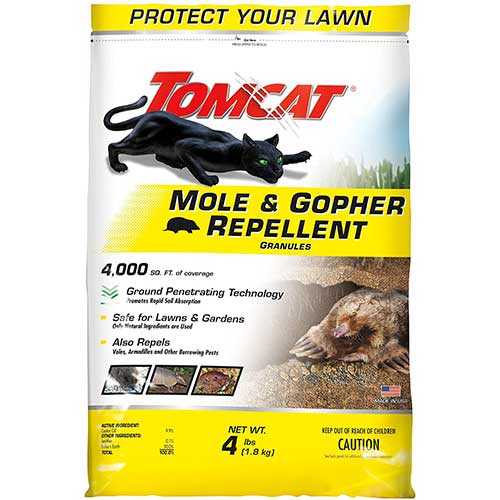
This is Tomcat Mole a Gopher Repellent. When you go cruising for mole removal options, you’re going to run into a lot of Tomcat products. These guys have a special mission, it seems, to repel, expel, or otherwise wave adios to moles. Their repellent granules are a sort of powdery substance with a taste and odor that is quite foul to moles in your yard. Probably to you as well, but we don’t have to remind you not to eat mole repellent. This stuff is mixed with the infamously mole-reviled castor oil, their least favorite substance on earth.
One of the neat things about this product is how it mixes with water to penetrate the surface of your yard or garden. Pretty much no digging required! Just dump this good stuff along the length of your mole tunnels. It’s listed as being safe for lawns and gardens and treats 4,000 square feet of territory per bag. The bad news? Reviews are divided. About half of the reviewers rated this product poorly. The other half rates it as top-notch!
When you notice review trends along these lines, there are a lot of factors that could help to explain. The fact that half of consumers rate it highly means that the repellent can certainly work. The other half may have applied it incorrectly, used it to repel the wrong pest, distributed it in rainy weather, or a possible host of other things. Tomcat is by and large a reputable brand, but it isn’t perfect. And no pest control materials work 100% of the time.
Related Article: How to Get Rid of Groundhogs
Mole Fumigators (See Our Favorite)
A mole’s complex underground tunnel system becomes its own downfall with fumigation devices. Locate a tunnel, crack open a fumigator, and cover that bad boy up. The poisonous fumes will eke into the mole’s subterranean dwellings, poisoning them fatally. This is another removal option that leaves you with a potential surprise to find as you fix up your yard area. There is no telling where the mole was partying when the fumes hit, and the moles drop where they drop. If you’re fumigating the moles out of your yard, be careful not to inhale anything as you set the device up. And wash your hands afterward. If it can kill a mole, your body probably won’t like it either.
6. The Giant Destroyer Fumigation Cartridge
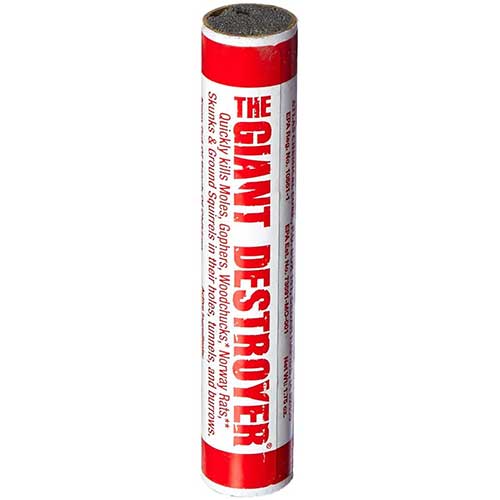
This fumigator product is neither giant nor does it destroy giants. One wonders at the title, but the real question is this: Does The Giant Destroyer destroy moles? Yes, it does. This is a small gas cartridge that can be inserted into a section of your mole tunnel. Dig up an entrance to the tunnel, drop the active cartridge, cover the hole, and walk away. This is a fast-acting toxin, and it will put down moles, squirrels, groundhogs, skunks, and other chihuahua-sized animals that you have decided you need to ice for some reason.
The Giant Destroyer is a dangerous chemical that should be maintained with great care before use. It is marketed as a “rodent gasser,” but you do not want this stuff in your lungs. It also comes in a four-pack, so unless you’re using all four, store the remaining cartridges up high, out of reach of children. And adults who are slow on the uptake.
The fumigation technique works because of the closed networks that moles build underground. Moles are not big on doors, so all the tunnels are completely free for the fumes to pass through. One issue that might cause your cartridges to fail, though, is a natural cave-in, which will stop the fumes from progressing. Such a thing could be tough to locate, so if a couple of attempts at fumigating fail, consider that the mole problem may be out of your reach without a different tool.
7. Apello Solar-Powered Mole Repeller (Not Recommended)
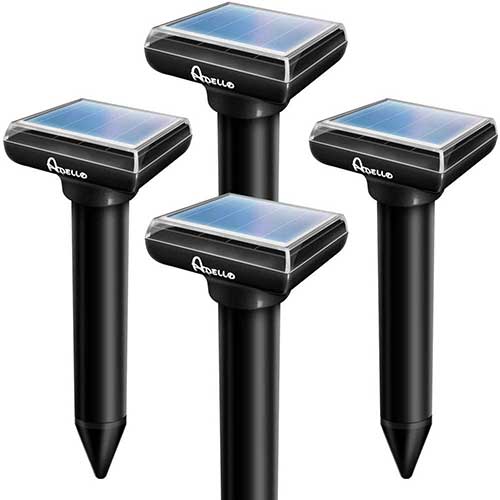
I have not personally tested this product so I can’t give it my stamp of approval. After testing many similar products on a variety of pests and reading research on whether or not ultrasonic repellers work, I personally don’t believe they are very effective. That said, if you’re desperate and have some extra money to experiment with there is a slight chance it may work. The Aello repeller (nice ring to it) is a solar-powered stake with a flat top for absorbing sunlight. Dunk this puppy in a mole tunnel and leave it there. For a long time. Until the moles leave, basically. This stake comes in a pack of six, so you’ll want to carefully space them across the mole tunnel network. As always, you’re aiming to stake the active or main tunnels.
There are no poisonous chemicals involved and no lethal mechanisms. No weird smells or finicky traps. The Apello stakes vibrate every thirty seconds, emitting sonic pulses and local trembling in the ground (noticeable chiefly to the moles, not you). Moles hate the sonic pulses and it makes them flee from areas where the stakes are located.
The emissions from the stakes are “highly irritating” to small rodents, who pack up and leave your yard pretty quickly. These are predictably the priciest option on our list, but they’re also the highest-rated. Makes sense to us — if it works, it’s worth the investment.
Get Rid of Moles: What’s Your Best Bet?
If you need those moles out, and you need them out quickly, there are few options more effective than a trap with bait in it. Lethal spike/blade traps, in particular, make fairly short work if you catch our drift. Attach some bait to your trap, pop it into the ground, check it the next day.
If there isn’t a dead mole stuck to it, place the trap somewhere else. Move it about once per day until you see results. If it isn’t working for some reason, a fumigator can really do the trick. You can mix and match as you see fit when it comes to the above-mentioned tools. Try herding moles into a baited and trapped area with repellent, for example.
Any of the products will tend to work better in either spring or Fall when the moles are most active. Winter is probably the worst time to attempt mole removal, particularly since the ground will be frozen. On the bright side, if it is winter, the moles probably aren’t actively digging a ton beneath your yard area, so you can afford to wait for spring.
More Information about Moles
To get rid of these pests, one valuable thing is to do is learn everything you can about moles. Moles are subterranean mammals, meaning basically that they are hairy and live underground. If they already sound like something to avoid, you’re in good company, reader. We are not fans either. Moles look a little like guinea pigs with no eyes and enormous hands. Like fuzzy little men who go to the gym, but only do farmer’s walks and other grip exercises. No joke, moles have powerful forelimbs. This is what allows them to burrow and dig tunnels, creating cozy little networks they can travel out of sight of predators.
They do actually have eyes, but these are incredibly small and inconspicuous, so it looks at first glance like moles are missing something very important on their faces. In fact, mole eyesight is pretty poor. But who needs 20/20 vision when you spend all day in the dark, digging for insects? They can use their sensitive, hairless snouts to help navigate dark environments. Alright, those noses are sort of adorable.
But mole diets are not very appetizing. Moles are insectivores, so they live on a diet of earthworms and grubs, mainly. The insects they eat include damaging pests who devour plant life. You wouldn’t want to use a mole to control a pesky bug population though. Moles come with their own set of problems.
Moles Digging Tunnels
That whole digging business? Moles will tunnel in your yard or garden, sometimes up to three feet deep. The problem is that this is highly disruptive to your beautiful plant life. Not only that, but they leave unsightly mole mounds wherever they tunnel, long streaks of disrupted earth and soil. Moles don’t actually cause serious damage to the environment, and in fact, they actually aerate soils. But they are not ideal gardening assistants, that’s for sure.
Moles spend most of their lives beneath the surface, which means that they can do a lot of damage to your garden over time. In fact, they are so good at tolerating carbon dioxide underground that they only come out into the open to mate! This seems oddly reversed, but we’re pest control gurus, not mole psychologists.
Moles do dig at high speeds though. If you think you’re a pro with a shovel, think again. Moles can dig up to 150 feet of tunnels on a single day. What a work ethic! This also means you will have a heck of a time finding them before they tunnel your yard area to smithereens.
You Are Now Ready for Mole Patrol
There you have it, our overview on how to get rid of moles! If you have run clean out of ideas and nothing seems to work, refer back to our guide to see if there’s anything you haven’t tried. Otherwise, it may be time to call the pros. Exterminators can work with you to find a solution with which you are comfortable, and that won’t bust up your backyard.
There are of course more products out there than those featured here, but this page should give you an idea of what’s available, and for what price.
Related Article: How to Get Rid of Voles
Most Important Mole Removal Tips
- Try to get rid of moles in the spring or fall. They are most active during these seasons, and you’ll have a much easier time of it. In particular, winter is a rough season for moles to work. The frozen ground will be a challenge.
- If you see roundish disturbances in the soil, and they stretch long distances, double-check for volcano-looking mini mounds. If you find both of these, you’re almost certainly looking at a mole problem.
- Always do a little recon before you try to get rid of moles. Look for straight, long tunnels with lots of branches, or tunnels that run the perimeter of your yard area. Poke your finger through prominent sections of these tunnels. If the moles repair your damage within a couple of days, you have your target.
- When considering your mole removal options, remember the four main tools at your disposal: Traps, baits, repellents, and fumigants.
- Traps are highly effective, but the lethal ones work best. They work even better with baits, which seem to be most effective in worm or grub form.
- Repellents can be helpful, but sonic repellers are one of the highest-rated control tools on the market.
- Fumigants can be effective, but they’re a little extreme, and definitely toxic to breathe.
- Avoid insecticides, as these can kill off valuable insect life that help your yard and garden really thrive.
If you have an infestation in your home or yard, Pest Control Gurus are you, go-to guys, for solid solutions. Check up on our site for updates, reviews, recommendations, and of course, tactics for getting rid of pests for good. Good luck out there, and always exterminate/remove safely.
My name is Blane and I’m a life-long resident of Southeastern Louisiana. I’ve been working as Pest Control Technician and Inspector for about 1.5 years now.
I’ve worked in many other industries as well, including consulting, managing, as well as at the ground level in fields including Food Service, Corporate Automotive sales, and finance. Whether it be providing counsel, content, or hands-on support; my goal remains to add value to the lives of the people I serve.
If you have any questions regarding pest control, leave them below. I would be happy to help you out in any way I can.

I get my moles by inserting a water hose in the tunnel and when they stick that little snout out they are a goner.
Hello Blane, this is the best and most informative piece I have ever read on the subject of moles, but I believe I might have voles is this information the same for ridding my yard of them as well?
I really enjoyed the humor you put in this and had to laugh many times. I have not seen one other than here, but moles are on the line between cute and ugly.
One thing puzzles me. You say they don’t damage or eat the plants. We had a space filled with hostas. My husband swears he saw them pulling the hosta plants down more than once. We had to take out the hostas (deer ate them too even though they were next to the house under a large window). Our yard seems lumpy rather than the hills you describe. In the hosta area I do notice holes with fresh dirt. Is there any other kind of creature it could be? I don’t think so. We don’t have gophers in Maryland.